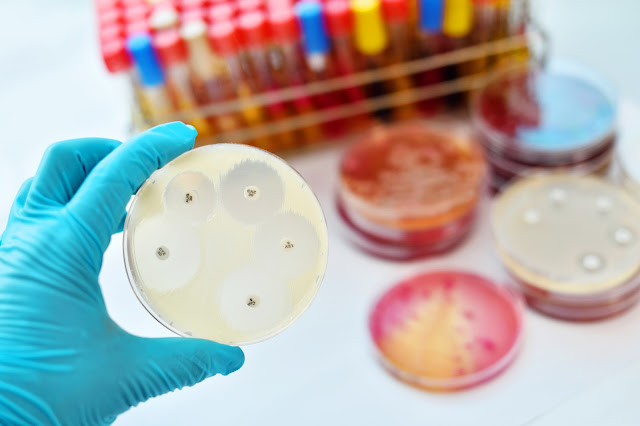Antimicrobial Susceptibility Testing Market Is Estimated To Witness High Growth Owing To Increasing Prevalence of Drug-Resistant Infections
 |
| Antimicrobial Susceptibility Testing Market |
The global Antimicrobial Susceptibility Testing Market is estimated to be valued at US$ 3,525.75 million in 2022 and is expected to exhibit a CAGR of 6.4% over the forecast period 2022-2030, as highlighted in a new report published by Coherent Market Insights.
Market Overview:
Antimicrobial susceptibility testing is an essential tool in determining the
most effective antibiotic treatment for bacterial infections. With the rise in
drug-resistant infections, there is an increasing need for accurate and timely
antimicrobial susceptibility testing to guide treatment decisions.
Antimicrobial susceptibility testing helps healthcare providers select the
appropriate antimicrobial therapy, thereby improving patient outcomes and
reducing the spread of antibiotic resistance. This market offers various
products and solutions such as automated systems, culture and susceptibility
testing products, consumables, and software, which play a crucial role in
providing reliable and actionable results.
Market Key Trends:
One key trend in the antimicrobial susceptibility testing market is the
increasing prevalence of drug-resistant infections. The misuse and overuse of
antibiotics have resulted in the emergence of antimicrobial resistance, making
infections harder to treat and posing a significant global health threat.
According to the World Health Organization (WHO), antibiotic resistance is one
of the biggest threats to global health, food security, and development today.
Antimicrobial susceptibility testing plays a vital role in identifying
drug-resistant bacteria and guiding appropriate treatment choices.
For example, methicillin-resistant Staphylococcus aureus (MRSA) is a leading
cause of healthcare-associated infections, and antimicrobial susceptibility
testing helps identify effective treatment options for MRSA infections.
Similarly, increasing resistance to common antibiotics in urinary tract
infections necessitates accurate susceptibility testing to guide appropriate
therapy.
PEST Analysis:
Political: The regulatory environment and government policies play a crucial
role in shaping the antimicrobial susceptibility testing market. Stringent
regulations govern the use and approval of antimicrobial susceptibility testing
devices and solutions. Government initiatives to combat antimicrobial
resistance drive market growth.
Economic: Increasing healthcare expenditure and government funding for research
and development in the field of antimicrobial susceptibility testing contribute
to market growth. The cost-effectiveness of these testing methods also plays a
vital role in their adoption.
Social: Rising awareness about the importance of appropriate antibiotic use and
the impact of antimicrobial resistance on public health drives the demand for
antimicrobial susceptibility testing. Increasing patient awareness and demand
for personalized medicine also contribute to market growth.
Technological: advancements in technology have revolutionized antimicrobial
susceptibility testing, leading to the development of automated systems and
advanced software solutions. These advancements improve the accuracy, speed,
and efficiency of testing, thereby driving market growth.
Key Takeaways:
1: The global
antimicrobial susceptibility testing market is expected to witness high
growth, exhibiting a CAGR of 6.4% over the forecast period. This growth can be
attributed to increasing prevalence of drug-resistant infections globally. The
misuse and overuse of antibiotics have led to the emergence of antimicrobial
resistance, making it crucial to identify effective treatment options through
accurate susceptibility testing.
2: North America is expected to dominate the antimicrobial susceptibility
testing market due to the high prevalence of drug-resistant infections,
well-established healthcare infrastructure, and favorable government
initiatives. However, the Asia Pacific region is expected to witness the
fastest growth during the forecast period. Rising healthcare expenditure,
growing awareness about antibiotic resistance, and increasing investments in
healthcare infrastructure contribute to this growth.
3: Key players operating in the global antimicrobial susceptibility testing
market include Thermo Fisher Scientific Inc., BIOMÉRIEUX, HiMedia Laboratories,
Alifax S.r.l. Italy, Creative Diagnostics, Resistell AG, Danaher, Becton,
Dickinson and Company, Merck KGaA, Bio-Rad Laboratories, Inc., Bruker, Nissui
Pharmaceutical Co., Ltd., F. Hoffmann-La Roche Ltd., Synbiosis, Mast Group Ltd.,
ELITechGroup, Flinn Scientific, CONDALAB, Accelerate Diagnostics, Inc., and
Zhuhai DL Biotech Co., Ltd. These key players focus on product innovations,
collaborations, and acquisitions to strengthen their market presence and expand
their product portfolio.
In conclusion, the growing prevalence of drug-resistant infections is driving
the demand for antimicrobial susceptibility testing. Improved testing methods
and advancements in technology are providing accurate and timely results,
aiding healthcare professionals in selecting effective treatment options. The
market is expected to witness significant growth in the coming years, with
North America leading the market and the Asia Pacific region showing the
highest growth potential. Key players continue to invest in research and
development to offer innovative solutions and maintain their competitive edge
in the market.



Comments
Post a Comment